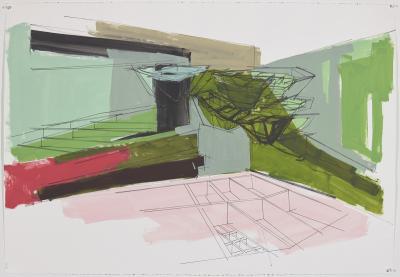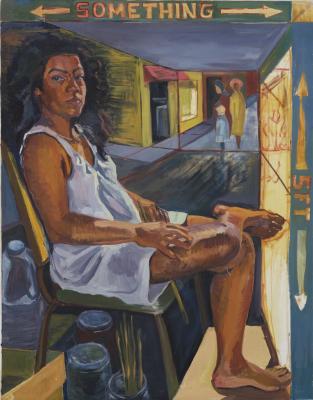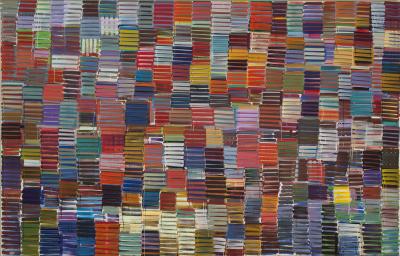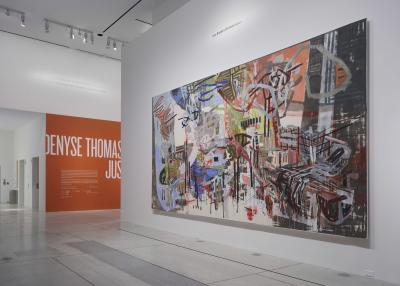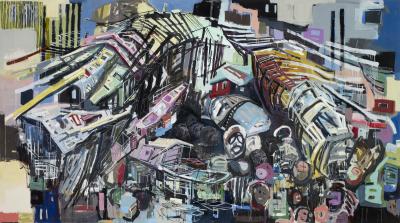Closing Reflections
just beyond co-curator Renée van der Avoird reflects on three works by Denyse Thomasos.

Denyse Thomasos. Rally, 1994. Acrylic on canvas, 274.32 x 426.72 cm. Courtesy of The Estate of Denyse Thomasos and Olga Korper Gallery. © The Estate of Denyse Thomasos and Olga Korper Gallery, Photo: Andre Beneteau.
Denyse Thomasos: just beyond [closed in February 2023] is a landmark retrospective exhibition at the AGO that explores the full scope of Thomasos’s career, featuring more than 70 paintings and works on paper.
The exhibition is co-curated by Renée van der Avoird, Assistant Curator, Canadian Art, AGO; Sally Frater, Curator of Contemporary Art, Art Gallery of Guelph; and Michelle Jacques, Head of Exhibitions and Collections / Chief Curator, Remai Modern. Featuring loans from museums and private collections in Toronto, Montreal and New York City, the curators worked closely with the artist’s family and gallerist, Olga Korper Gallery, to also include rarely seen sketches, photographs and documentary footage of Thomasos working in her studio.
We asked van der Avoird to share some candid reflections about three Thomasos works that resonate with her deeply.
Rally (1994)
To me, one of the most powerful works in the show is Rally (image at top). It is a massive canvas: 9 x 14 feet. Unlike Thomasos’s other monumental work from the mid-1990s, it is composed of repeated series of lines rather than cross-hatchings. The lines appear in a variety of jewel-like hues and are stacked into structures that resemble cargo or apartment buildings.
Thomasos painted Rally in Philadelphia. She moved there in 1990 to teach painting at the Tyler School of Art and Architecture at Temple University after completing her MFA at Yale. Philadelphia had a major effect on her studio practice. Hard hit by the crack cocaine epidemic, concentrated areas of the city suffered intense poverty and despair that highlighted racial inequities. In a recorded artist talk, Thomasos spoke about the heaviness of living there; and how, among the destruction she encountered, she would see certain houses painted bright colours, which offered moments of hope. These colours, which reminded Thomasos of her Caribbean roots, come through vividly in Rally.
When I look at Rally, I try to understand how many lines are layered beneath the surface, which leads me to think about the amount of labour and time that went into it. The built-up layers evoke a sense of depth, despite the fact that compositionally the work is very flat. I see energy stored within each brushstroke, a reminder of her physical interventions. The drip marks add a sense of immediacy and spontaneity. Artist Tim Whiten, who was a close friend of Thomasos’s, remarked during the 2021 AGO Study Days academic symposium that her canvasses are imbued with “chemistry and alchemy”. That statement rings true, especially within the urgent lines and gorgeous palette of Rally.
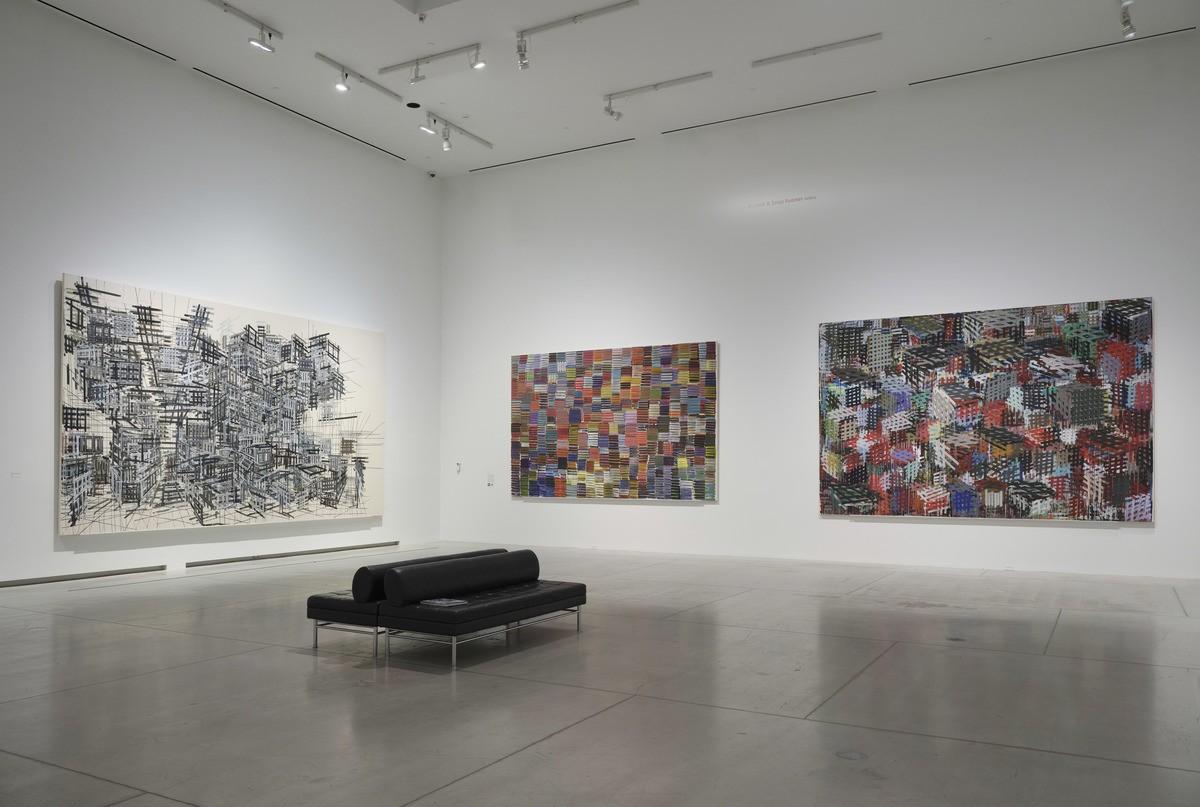
Installation view, Denyse Thomasos: just beyond, October 5, 2022 - February 20, 2023. Art Gallery of Ontario. Artworks: Virtual Incarceration, 1999; Rally, 1994; Urban Jewel, 1995 © The Estate of Denyse Thomasos and Olga Korper Gallery, Photo © AGO
Wyoming Suite (2000)
Thomasos loved to travel, and part of that included attending artist residencies across the world. A section of the exhibition is dedicated to a residency she completed at the Ucross Foundation in Wyoming. My co-curators Sally Frater and Michelle Jacques and I decided to display a suite of seven works on paper to show how focused Thomasos became while working in a residency. The seven works are similar in many ways: they are painted with the same palette, with spontaneous marks laid quickly on paper, drip marks almost as important to the composition as the painted lines themselves. These experimental paintings show that Thomasos was working through ideas by repeating motifs like the cage form and playing with variations of it.
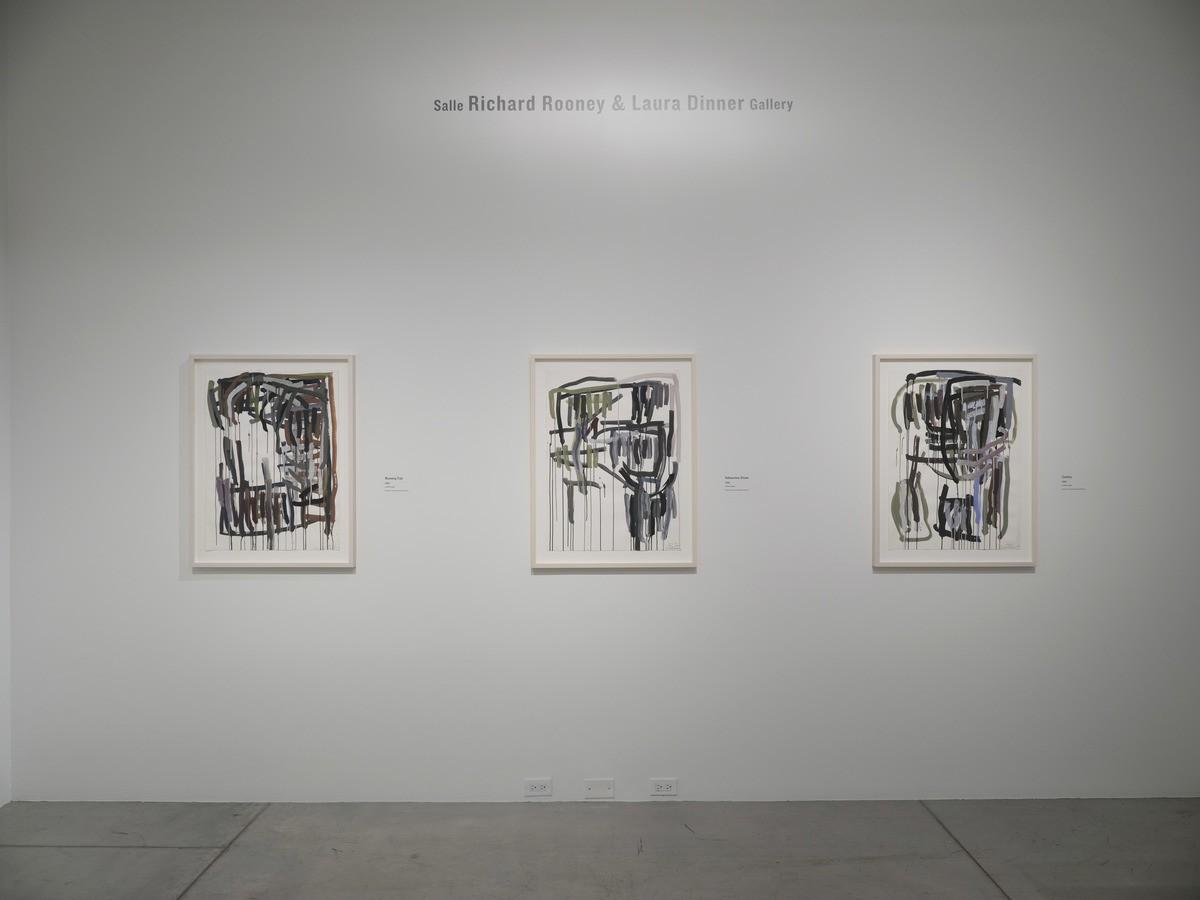
Installation view, Denyse Thomasos: just beyond, October 5, 2022 - February 20, 2023. Art Gallery of Ontario. Artworks: Wyoming Trail, 2000; Yellowstone Steam, 2000; Cowboy, 2000 © The Estate of Denyse Thomasos and Olga Korper Gallery, Photo © AGO
The Wyoming works are important because they trace an evolutionary moment when Thomasos’s approach to line becomes more gestural. They also reflect her dedication to the act of painting and a lifetime of learning. She noted that after each residency, she “taught herself” how to paint again. In this same gallery, we included a vitrine with journals and sketches to illuminate other generative aspects of Thomasos’s process.
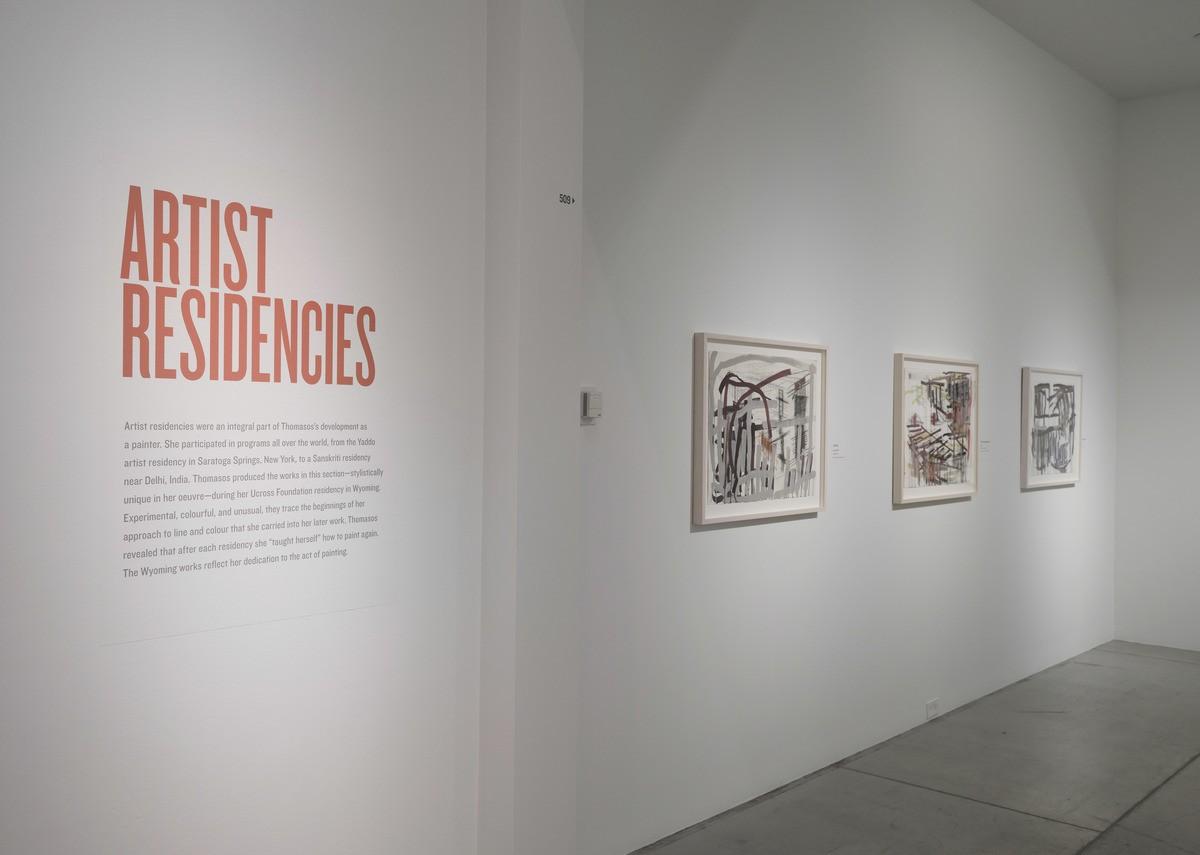
Installation view, Denyse Thomasos: just beyond, October 5, 2022 - February 20, 2023. Art Gallery of Ontario. Artworks: Untitled, c.2000; Open Range Wyoming, 2000; Cowboy Interior, 2000. © The Estate of Denyse Thomasos and Olga Korper Gallery, Photo © AGO
Excavations: Courtyards in Surveillance (2007)
In her essay “An Aesthetics of Survival”, featured in the just beyond catalogue, Trinidadian scholar Dr. Marsha Pearce considers how Thomasos’s Caribbean heritage shapes her work. Pearce describes a duality that comes through: her paintings depict “architectures of confinement” for Black people, from the slave ship to cramped urban dwellings and biased justice systems, but I insist that they also bear a particular will to survive, as articulated by Caribbean people.” Notions of survival and endurance underscore the entire narrative of the exhibition, and Excavations: Courtyards in Surveillance is a powerful example of these themes.
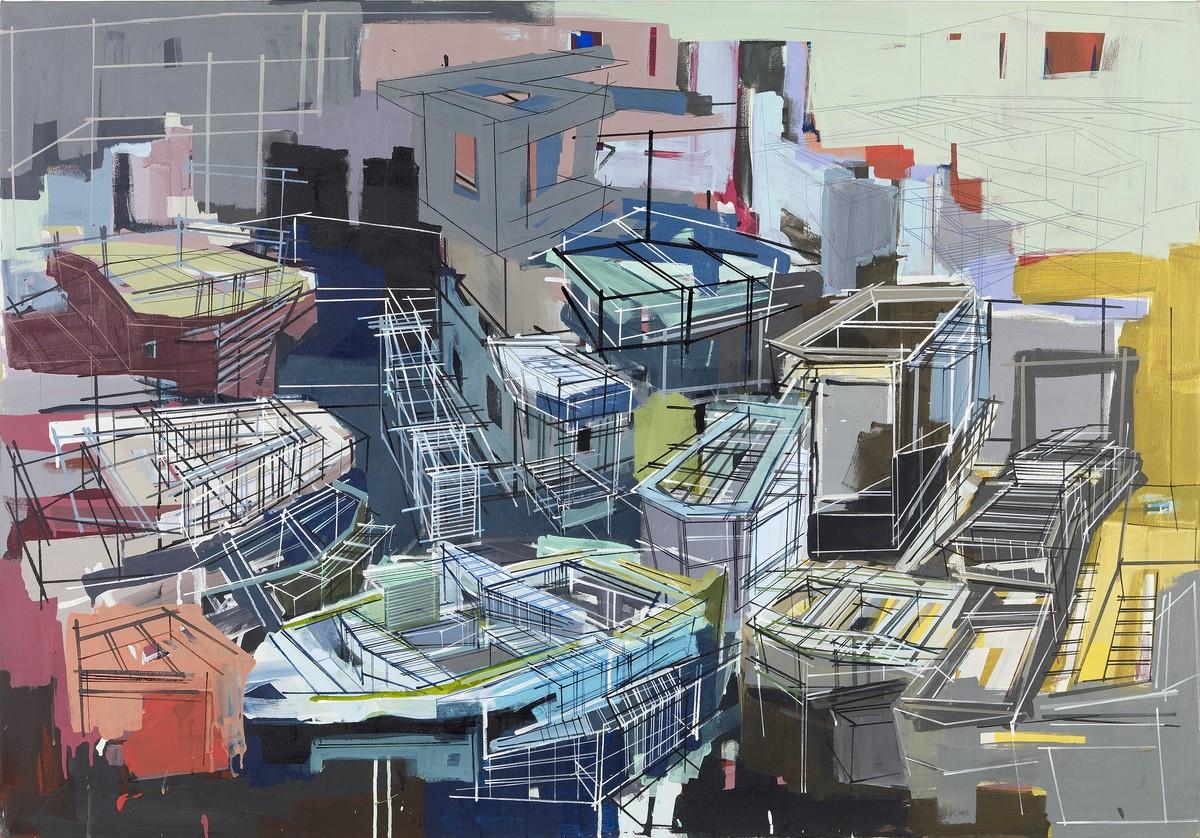
Denyse Thomasos. Excavations: Courtyards in Surveillance, 2007. Acrylic on canvas, 106.68 x 152.4 cm. From the collection of Bob Harding. © The Estate of Denyse Thomasos and Olga Korper Gallery, Photo: Michael Cullen.
More specifically, this mid-sized acrylic painting conjures the notion of being watched or being policed. The justice and carceral systems are subjects Thomasos was deeply concerned with. She represented them in her work in various ways, from the cross-hatched cage forms to circular panopticon-like structures. Her research into the carceral system included visits to maximum-security prisons in the United States. She remarked that the interiors of prisons were often painted bold or pastel colours, which are believed to have positive psychological effects on prisoners. Some of these colours come through in the palettes of her mid-2000s paintings, like Excavations: Courtyards in Surveillance.
As in all Thomasos’s work, this painting is about the legacies of Black life and structures of oppression. It is also deeply personal. The year before she died, the artist wrote: “More and more, I recognize that my interest in imprisonment in the outside world actually stems from my own feelings of isolation and the ways I have had to survive that. With every line, every mark, it’s a language that I weave together to survive.”


